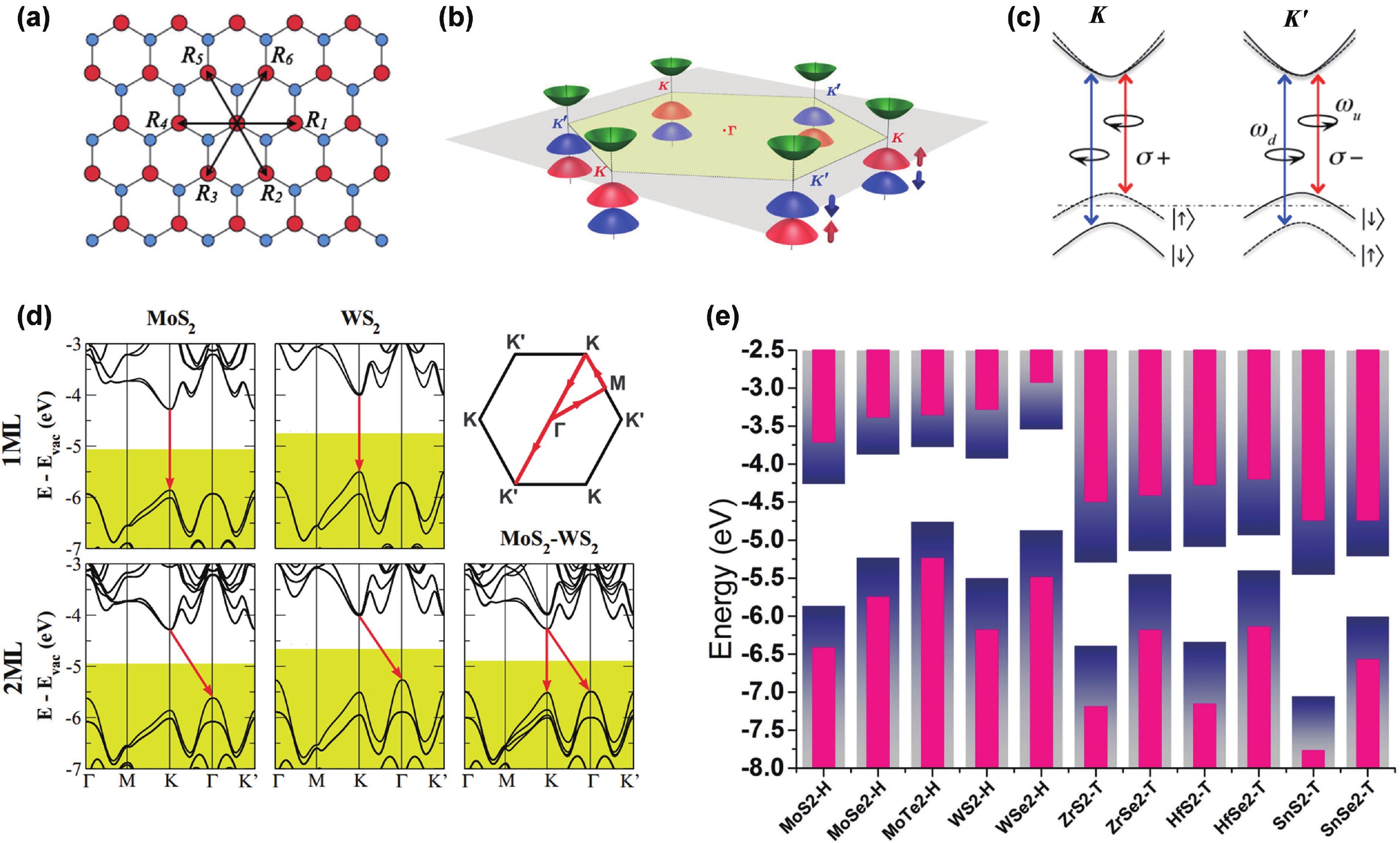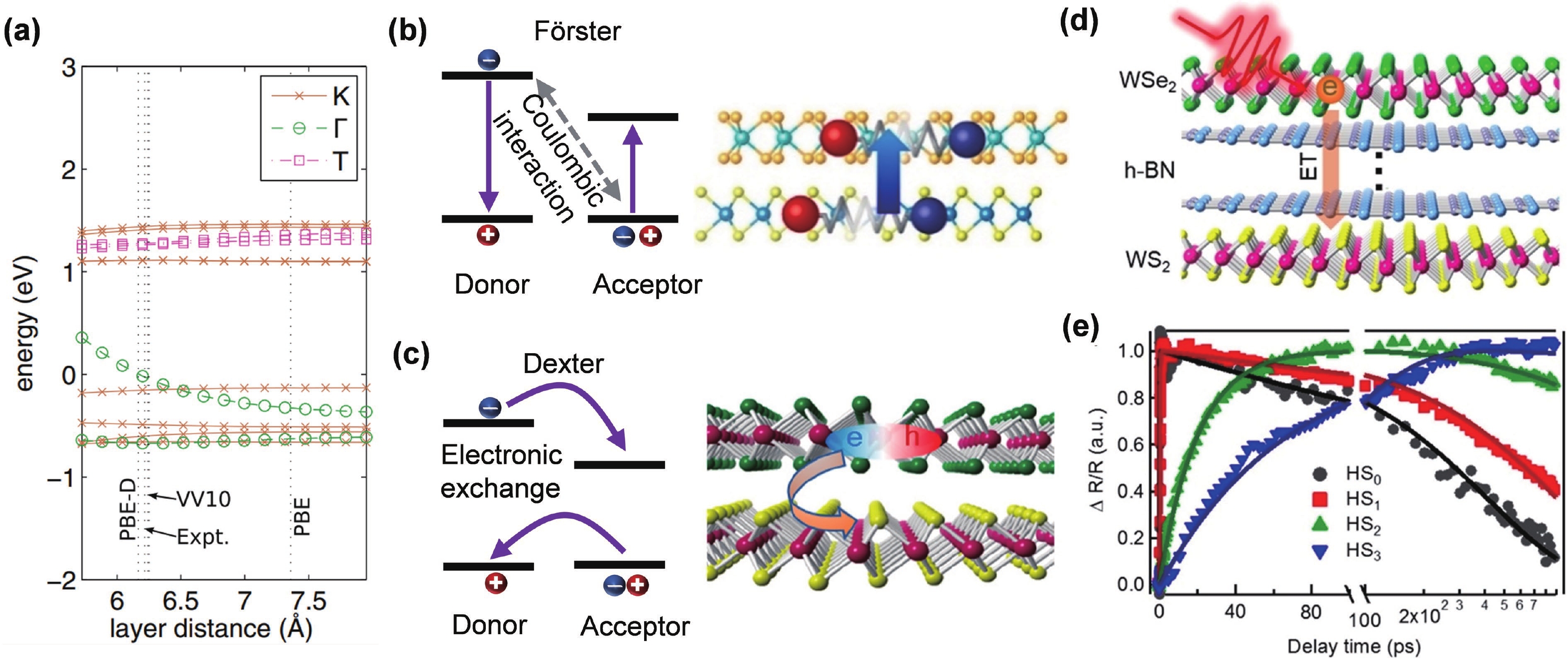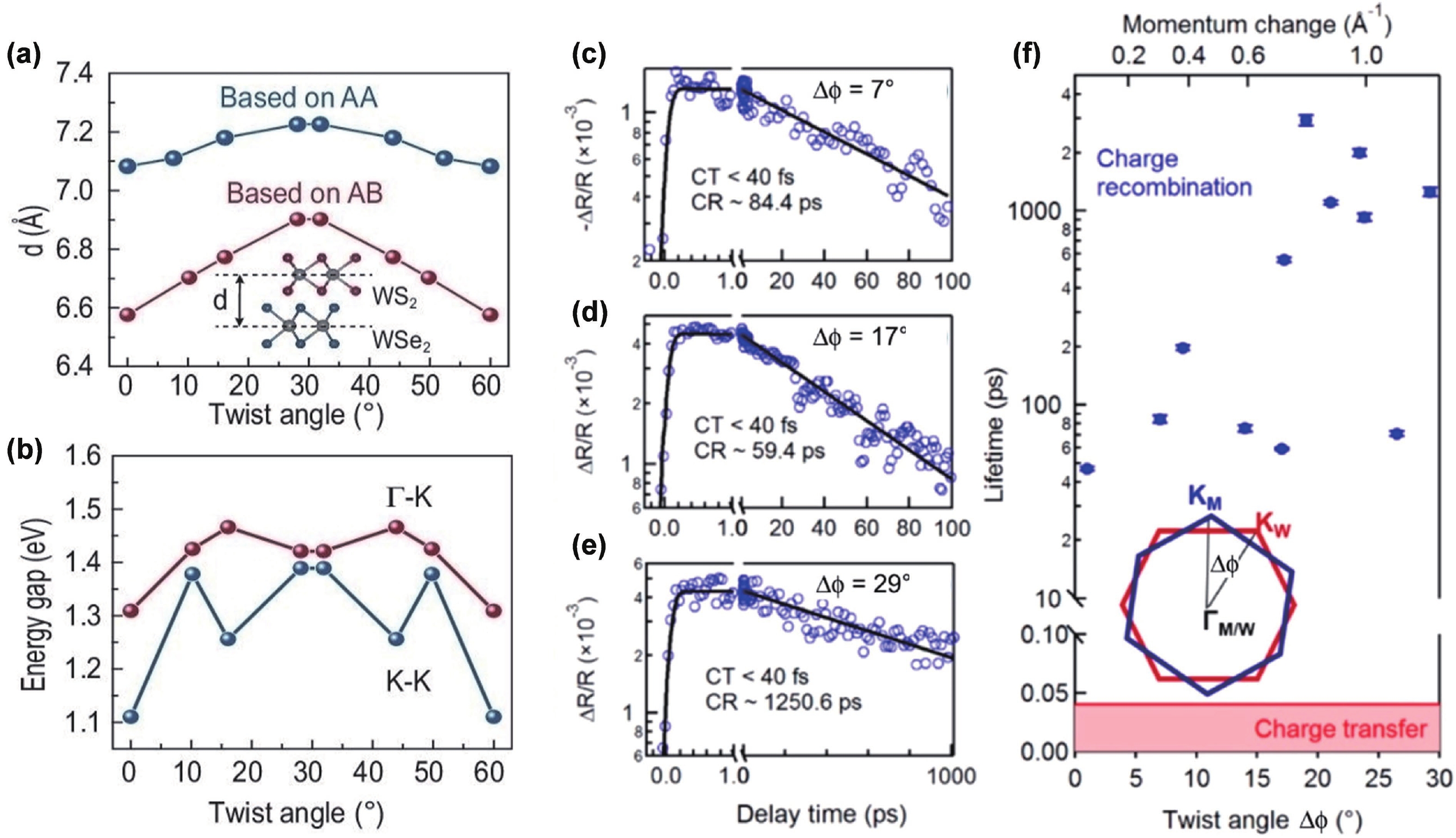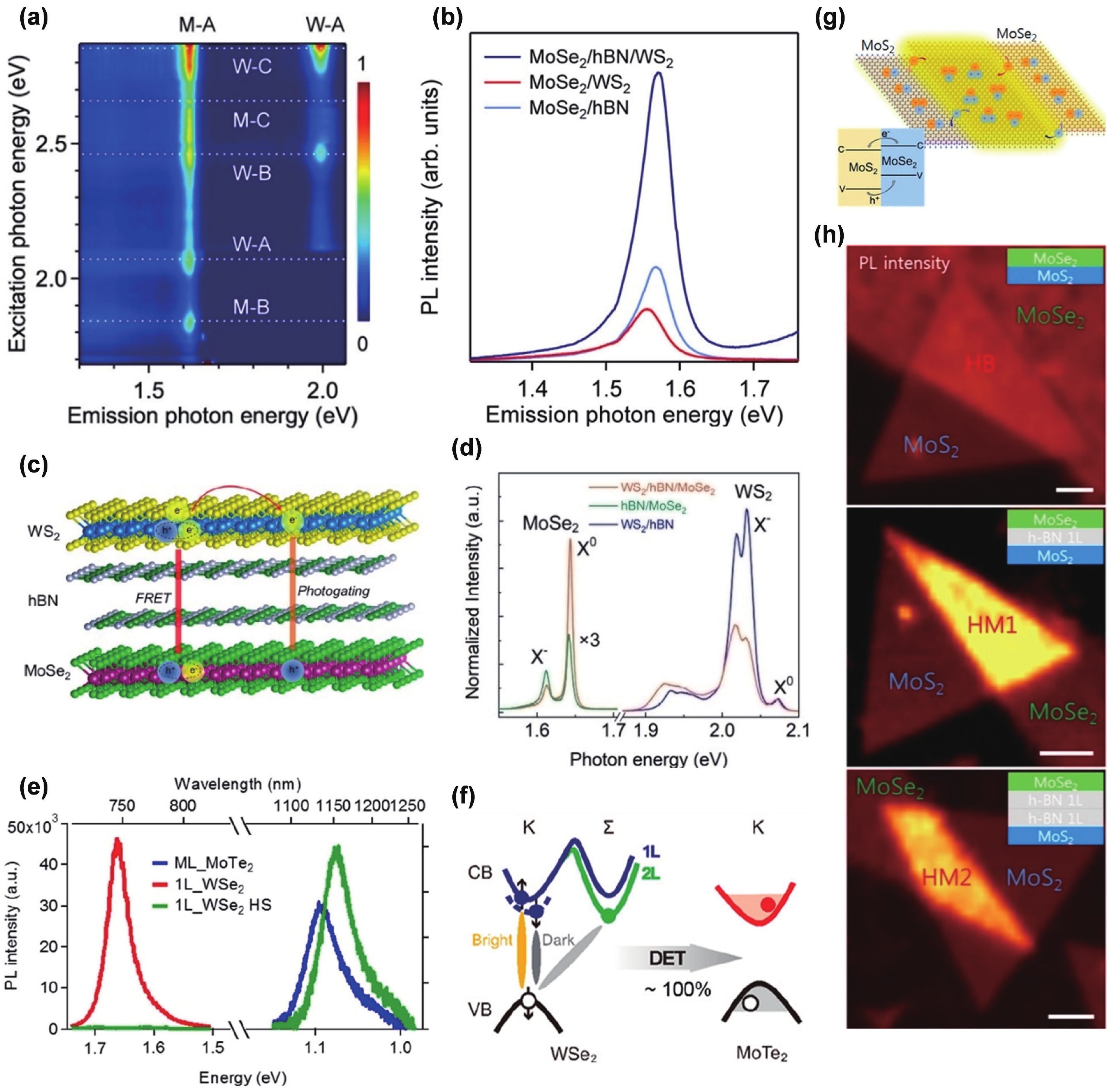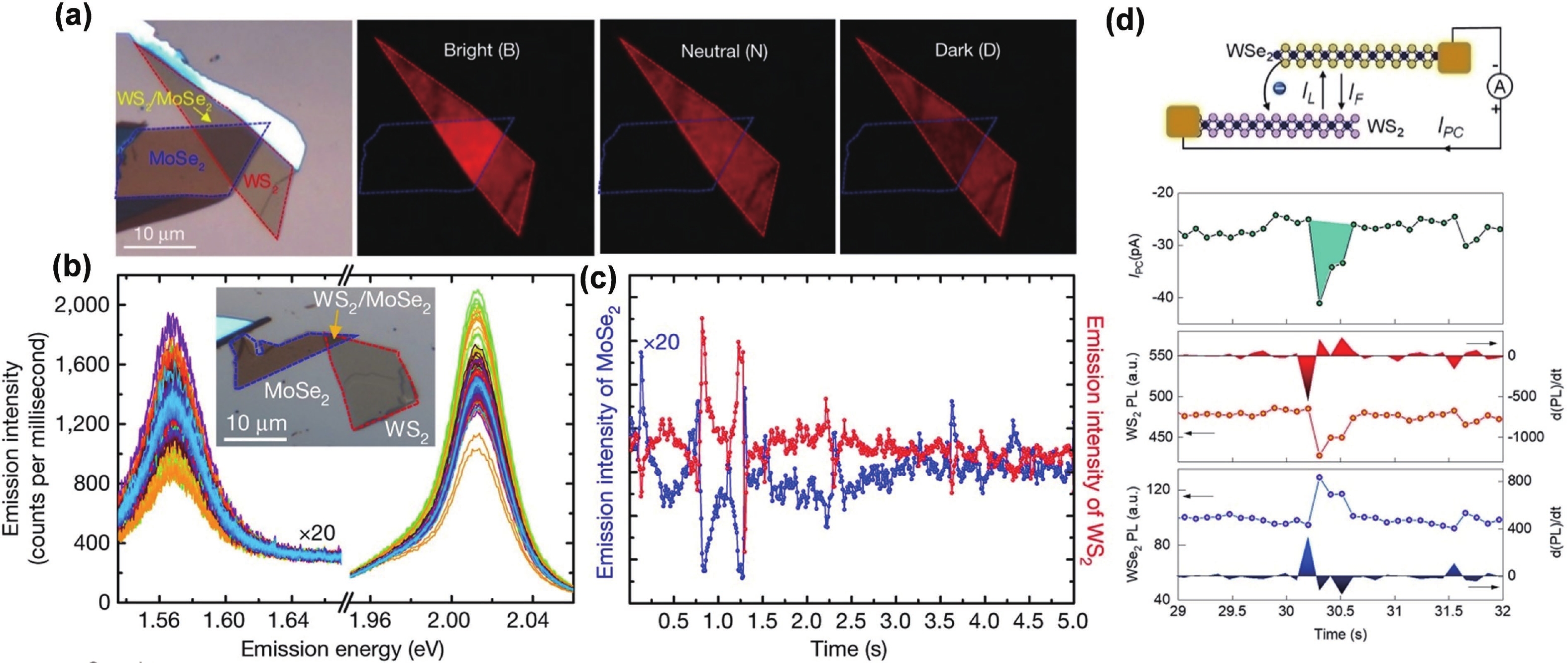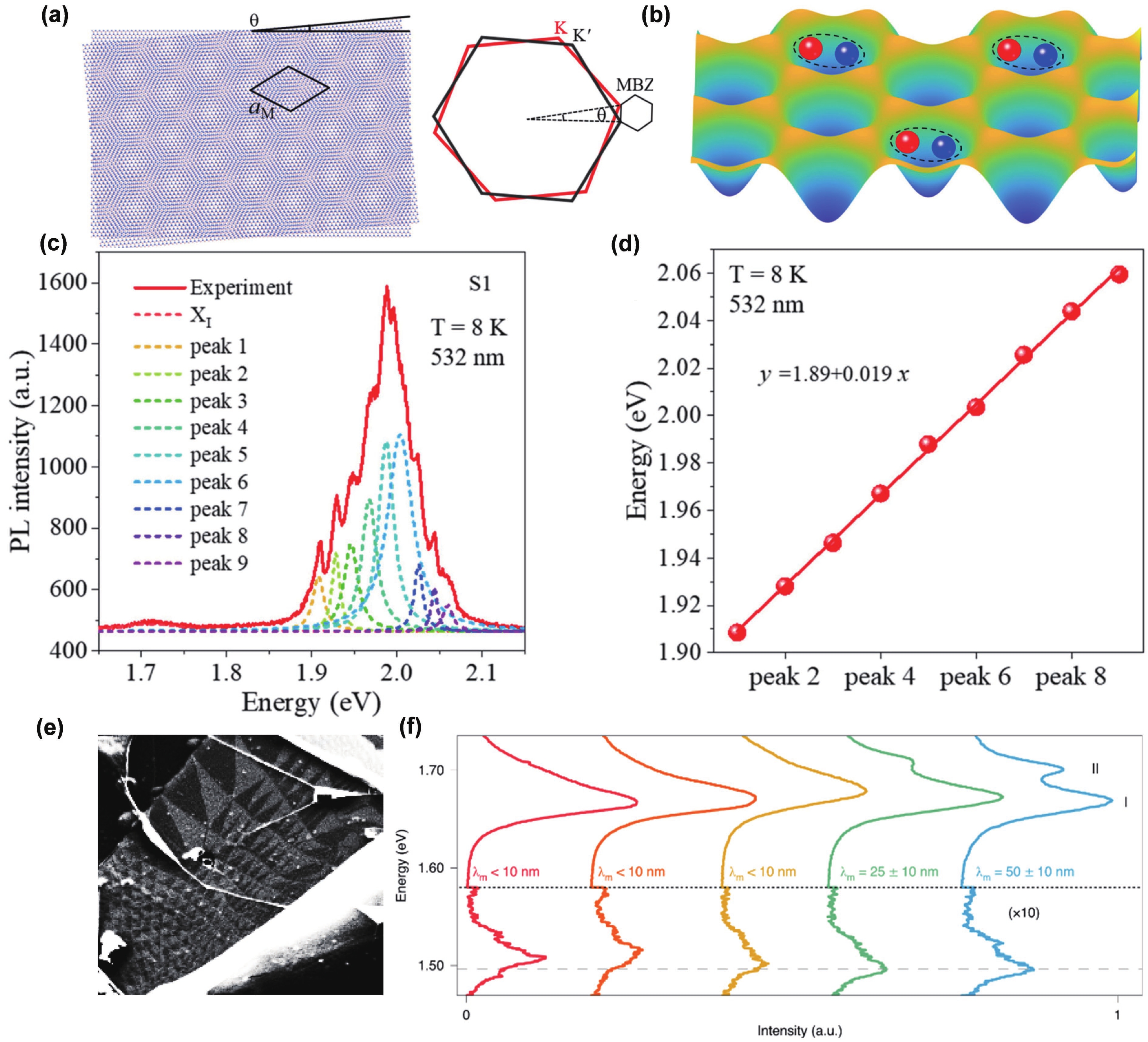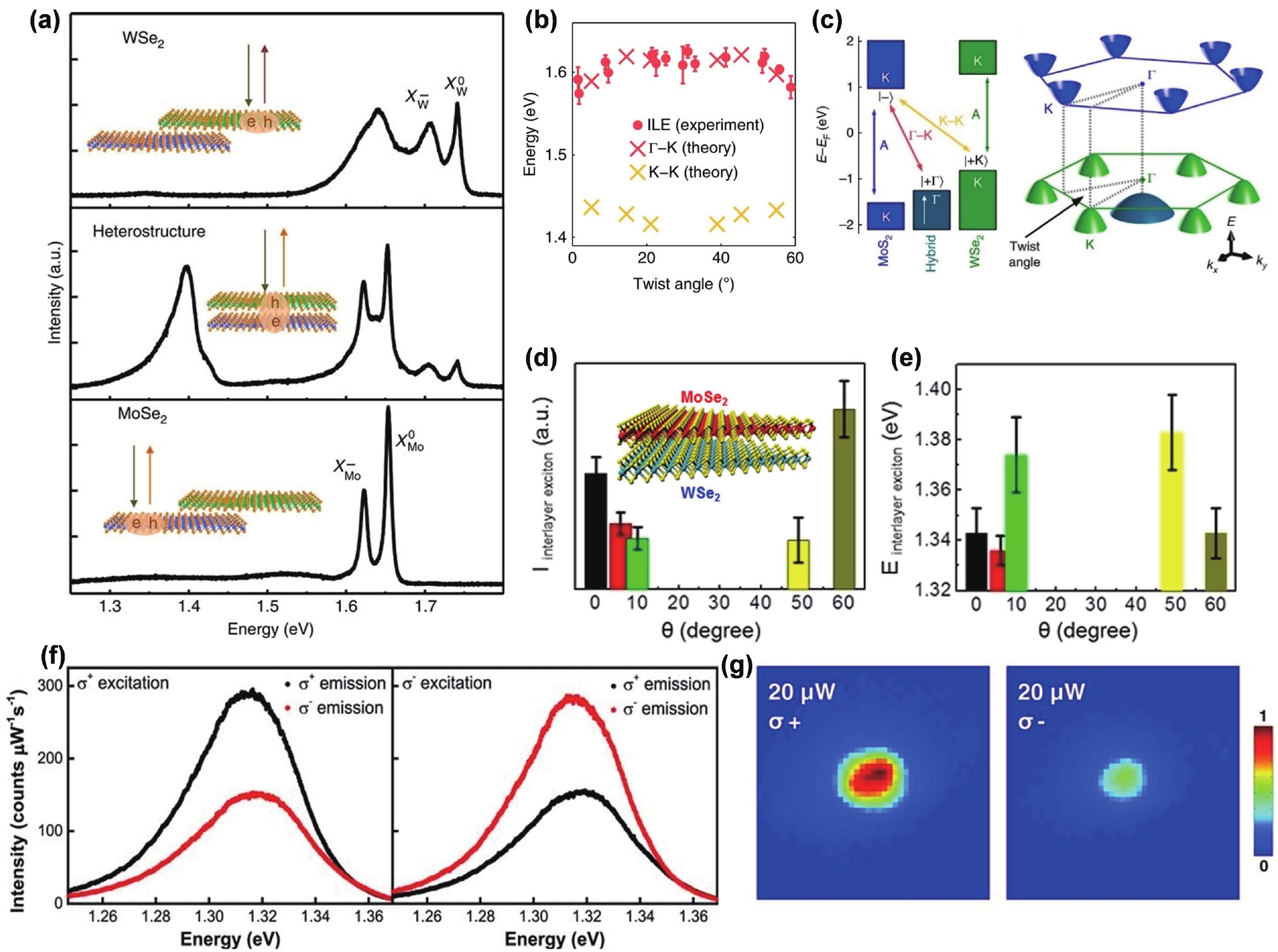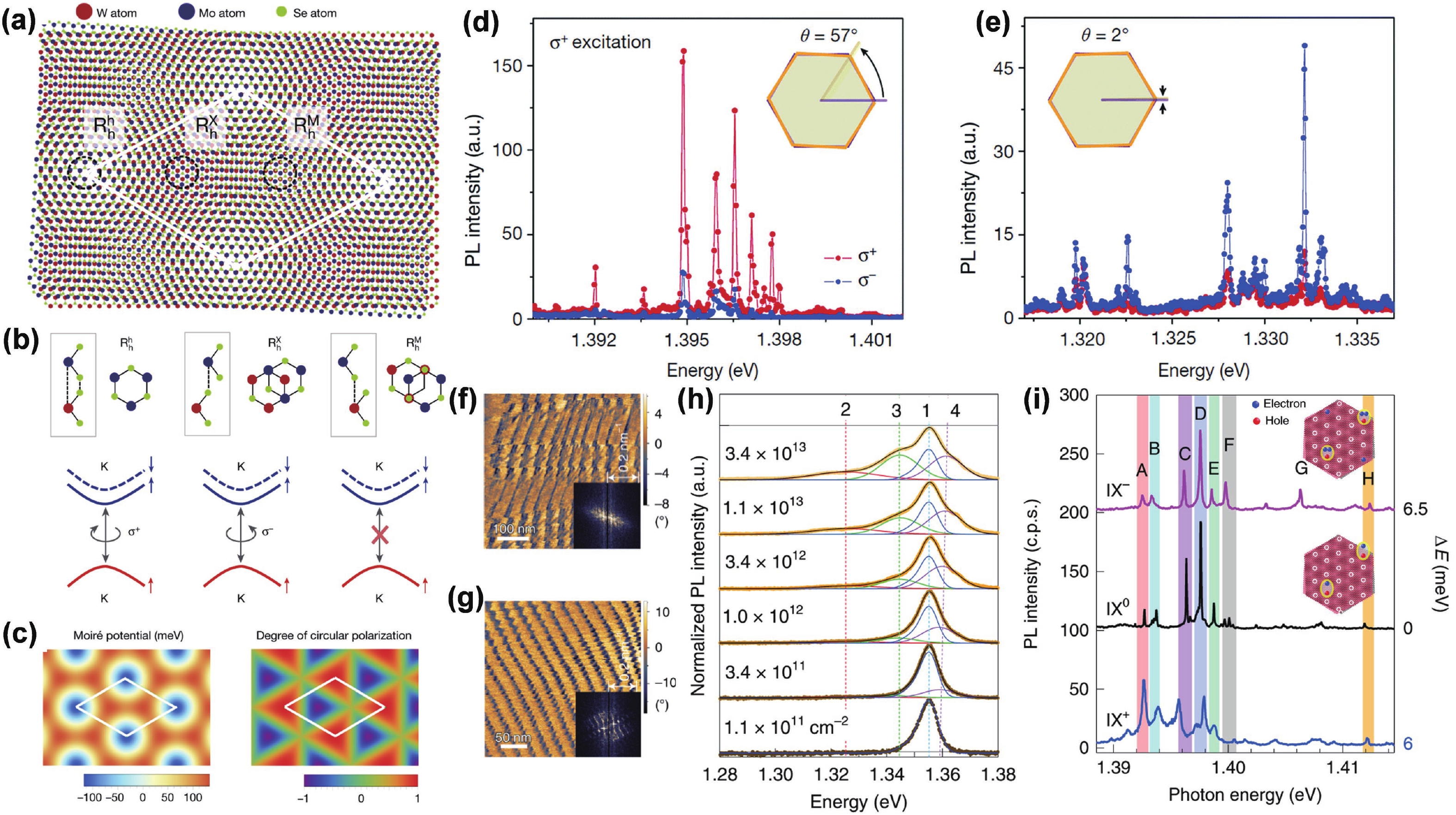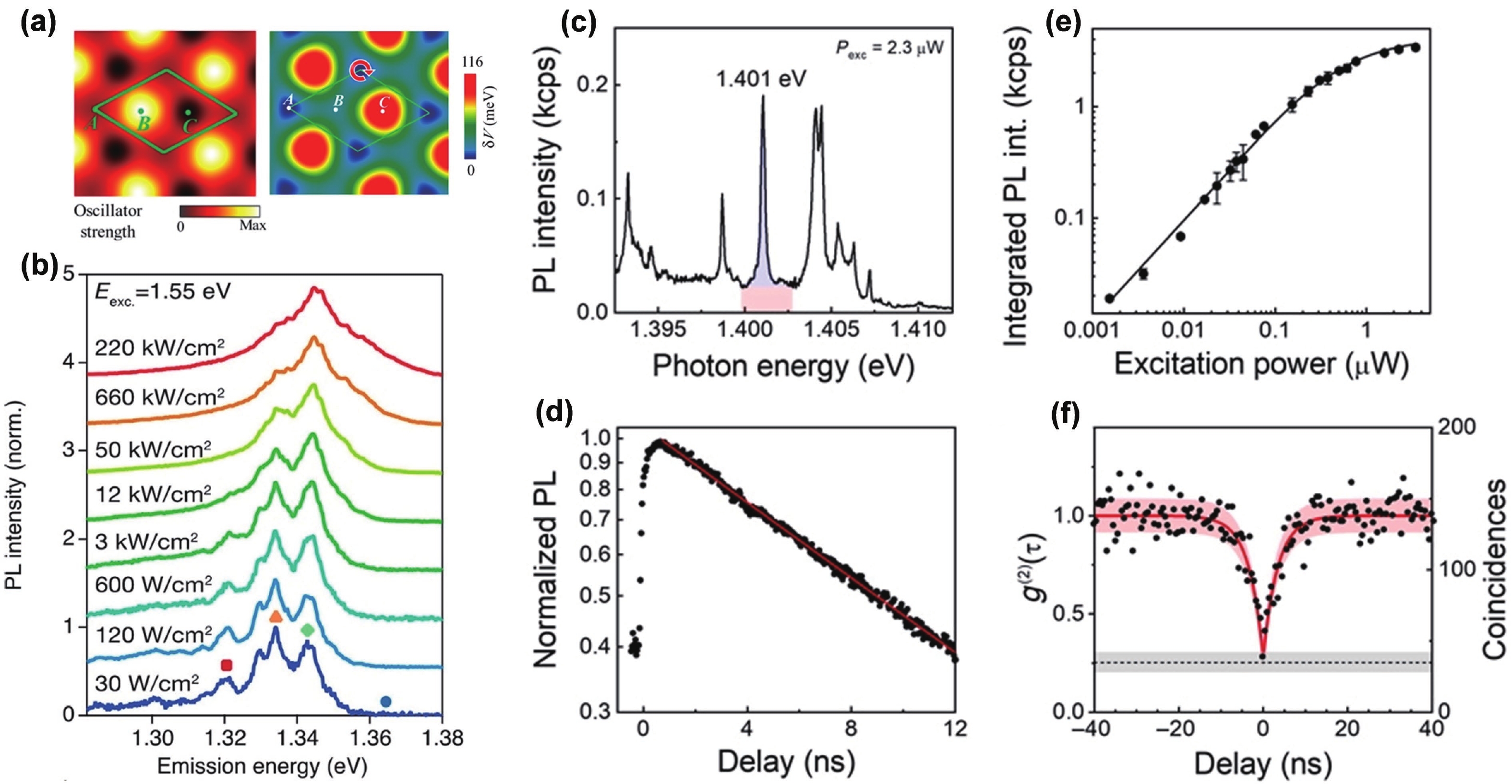1. Introduction
Low-dimensional luminescent materials have been broadly investigated due to their distinctive optical and optoelectronic properties, which originate from the quantum size effect[1, 2]. Among various low-dimensional materials, atomically thin transition metal dichalcogenides (TMDs) — including the extensively studied WS2, MoS2, WSe2, and MoSe2 monolayers — are semiconductors with direct bandgaps at the visible and near-infrared energies[3]. In such a two-dimensional (2D) system, the reduced Coulomb screening leads to strong excitonic effects[4, 5], which account for a great variety of the excitonic states formed by tightly bound electrons and holes. As a result, multiple excitonic species dominate the luminescent properties of TMD monolayers, which guarantees TMDs future applications in optics and optoelectronics.
Thanks to the atomically flat surface and the weak van der Waals (vdW) force, vertically stacked TMDs have provided a fruitful platform for synthesizing 2D luminescent materials with enormous flexibility. Chemical vapor deposition[6], physical epitaxy, and polymer-based transfer techniques[7-9] are efficient methods for fabricating 2D heterostructures. Interlayer coupling in homo-/hetero-bilayer TMDs plays a key role in the generation of novel 2D emitters by forming diversified excitonic states[10]. Notably, we use the broad definition of “2D heterostructures” as proposed by Wang et al.[11] to include both 2D homobilayers (two of the same materials) and 2D heterobilayers (two different materials), and progresses related to light emission properties of both will be discussed in this Review. Although substantial progresses have been achieved to engineer the 2D emitters by applying an external field, e.g., electric/magnetic field or strain, they are not the focus of this review.
We will mainly cover several factors that are important in engineering the interfacial structures of 2D heterostructures, including the electronic structure of each monolayer, the relative band alignment, the interfacial gap as well as the twist angle. Various interface interactions in heterostructures can modulate the intralayer exciton by energy transfer and charge transfer. A specific stacking configuration, such as a twist angle (close to 0° or 60°), will lead to interlayer hybridization, thus the bandgaps of 2D bilayers might evolve from direct into indirect. At the same time, new excitonic states emerge, such as the interlayer excitons with electrons and holes residing in different layers. In addition, the superposition of atomic lattices in a 2D bilayer can produce large-scale periodicity, i.e., the moiré pattern. Moiré pattern arises from the lattice mismatch and/or the twist angle of the two component monolayers. The periodic moiré superlattice introduces a new periodic potential, which has been uncovered to trap intralayer and interlayer excitons, forming arrayed 2D emitters or even arrayed quantum emitters. Based on the huge progresses on twisted heterobilayers during recent years, twisted optoelectronics has grown to be a main stream of optoelectronics.
In this review, firstly, we introduce the basic strategies used to engineer the interface which can modulate the luminesce features of 2D emitters. Secondly, we discuss theoretical and experimental demonstration of emergent emissions in terms of intralayer and interlayer excitons, respectively. Finally, we summarize the advance of 2D emitters and emphasize their unique features. We also have a practical outlook on the applications. We hope this review can stimulate new strategies for designing novel 2D emitters and promote the development of optical information technology and optoelectronic devices.
2. Interface engineering of 2D heterostructures: basic strategies
2.1 Components
The intrinsic energy band structures and electronic states of components for fabricating heterostructures are basic determinants for the properties of an assembled structure. During the past decade, various 2D materials with different electronic structures have been used as components of heterostructures, including semiconductors, semi-metals, and insulators[12]. Differences in the intrinsic properties of the components enable the assembled heterostructures to exhibit diversity in optical and optoelectronic properties.
Here, we focus on the semiconducting MX2 compounds with M being Mo or W and X being S, Se or Te. The MX2 compounds have been broadly studied not only because of their stability at ambient conditions, but also benefited by their unique excitonic and valleytronic features. The band structures of TMD monolayers have the extrema at the K and K′ corners of the hexagonal Brillouin zone, which have distinctive spin and valley indices (Figs. 1(a) and 1(b))[13-17]. The excitons in TMD monolayers have large binding energies of hundreds of millielectron volts[18] and thus the Bohr radius is only of a few nanometers[19]. Due to the inversion symmetry breaking of TMD monolayers, the excitons are optically addressable based on the valley-contrasting optical selection rules at K and K′ valleys, i.e., direct interband transition in the K (K′) valley couples exclusively with the right (left) circularly polarized light (Figs. 1(b) and 1(c))[15, 16]. Moreover, the broken inversion symmetry also allows strong spin-orbit coupling of transition metal d orbitals, which are the main components of the conduction and valence bands at K and K′ valleys[20, 21]. Strong spin-orbit coupling causes spin splitting at the extrema of the conduction and valence bands, which results in two bright exciton states (electron and hole with the same spin)[22, 23]. The two bright excitons are generally referred to as the lower-energy A and higher-energy B excitons. Due to the time-reversal symmetry, the spin splitting has opposite signs in the K and K′ valleys, which couples the spin and valley degrees of freedom[15, 16]: the bright exciton is spin up in one valley and spin down in the other (Fig. 1(c)). Therefore, these optical selection rules qualify the emission of excitons in TMD monolayers to carry valley-contrasting optical helicity as well as the spin information of electrons. Additionally, there are also spin- or momentum-forbidden dark excitons with non-zero center-of-mass momentum which are related to photon scattering[24, 25]. Those dark excitons can greatly influence the emission properties, especially when their energies are lower than that of the bright excitons.

Homobilayers can be either prepared from direct exfoliation from the bulk crystals, or by stacking two monolayers after exfoliation. These two methods lead to disparate optical features corresponding to distinct interband transitions, since the interlayer hybridization between two identical monolayers is significant and highly sensitive to interlayer coupling conditions (Fig. 1(d))[26, 27]. In homobilayers, without any band offset, electron and hole states at the K and K′ valleys remain largely localized within each layer, whereas, homobilayers have degenerate exciton states in both layers, which has been manifested as the coexistence of both intralayer and interlayer exciton states at the K and K′ points[28-30].
TMD monolayers (and their alloys[33]) provide diversified band structures. This feature allows people to fabricate heterostructures with different types of band alignments (Fig. 1(e)), i.e. types Ⅰ, Ⅱ, and Ⅲ[34]. The charge transfer behavior is fairly different in three types of heterostructures. For type Ⅰ, the straddling band gap make electrons and holes both accumulate in one component with a smaller bandgap. For type Ⅱ, the staggered band gap with extrema of conduction and valence band in opposite components causes the separation of electrons and holes in different components[35, 36]. For type Ⅲ, the band alignment with a broken gap means that the conduction band minimum (CBM) of one component is below the valence band maximum (VBM) of the other. TMD heterobilayers are of type Ⅱ band alignment, with CBM and VBM in different monolayers. The energy offset between the extrema of the conduction or valence band can drive ultrafast interface charge transfer, especially when the interlayer gap is small.
2.2 Interlayer gap
In 2D bilayers, besides the band offset of the components, the interlayer coupling at the interface[37] and the electronic structures of bilayers[38] can be readily tuned by increasing[36, 37, 39] or decreasing[40] the real-space interlayer gap. The states around the K point and T point are insensitive to the interlayer gap, while Г-point states are different (Fig. 2(a))[41]. Here we summarize two types of gap-dependent interlayer interactions, i.e., energy transfer and charge transfer. The charge and energy transfer processes in TMD heterobilayers usually happen in the femto-to-nanosecond timescales and have been investigated in detail using the pump-probe spectroscopy with femtosecond resolution[35, 42, 43]. The dynamics of charge and energy transfer processes in various low-dimensional materials have been recently reviewed by Hu et al.[44].

The spin singlet ‘bright’ excitons in TMD monolayers have in-plane dipole moments. When the two layers are efficiently coupled in the heterostructure, the Förster energy transfer takes place, with the exchange energy across the interlayer gap by dipole-dipole interaction (Fig. 2(b))[45, 48]. The Förster energy transfer is effective in relatively long distance (<10 nm) and highly dependent on the distance[49]. When the distance is small (<1 nm), another type of energy transfer, namely the Dexter energy transfer emerges. The Dexter energy transfer relies on charge exchange interaction based on the overlap of electron clouds of donor and acceptor. In a type Ⅰ heterobilayer, electrons and holes will both transfer from one monolayer with a larger bandgap to the other with a smaller bandgap, leading to the Dexter energy transfer (Fig. 2(c))[46]. Moreover, the Dexter energy transfer can also occur between spin-forbidden triplet states, based on the Wigner spin conservation rule[46]. Unlike the Förster energy transfer which only allows the energy exchange between bright excitons, the Dexter energy transfer enables the exchange of both bright and dark excitons, thus offering an excellent strategy to brighten the dark exciton in TMD layers.
On another hand, interlayer charge transfer processes profoundly affect the features of each individual component and the heterostructure as a whole. The interlayer gap can efficiently affect the strength of the interlayer coupling and is an important determinant for interlayer charge transfer[50, 51]. For closely stacked heterobilayers, ultrafast optical measurements using pump-probe spectroscopy with femtosecond resolution have revealed that the charge transfer takes place within 40 fs in typeⅡ heterobilayers[10, 35, 42, 52, 53]. On the other hand, for loosely-contacted heterobilayers, the charge transfer rate was retarded exponentially with increasing distance between the layers. This is in agreement with the distance-dependent electron-transfer rate in the Marcus theory[50, 51]. With the increase of layer spacing, the charge transfer related kinetic process gradually slows down (Figs. 2(d) and 2(e))[47]. More interestingly, in vertical heterobilayers without any heating or annealing procedure, correlated fluorescence blinking between the two components appears, due to the intermittent interfacial charge transfer across the interlayer gap[36, 39, 54].
2.3 Twist angle
Besides component and interlayer gap, the third basic degree of freedom in interface engineering is twist angle. Following discussions in Section 2.2, it shall be noted that the interlayer distance of stacked 2D heterostructures can slightly vary under different relative orientation (twist) angle between the two monolayers (Figs. 3(a) and 3(b))[26, 55, 56]. According to the dispersion-corrected density functional theory calculations, the equilibrium-state bilayer separation is a function of twist angle θ. The theory indicates that bilayer separation of intermediate θ is larger than that of θ = 0° and 60° (Fig. 3(a))[26, 27]. Furthermore, based on previous theoretical studies, the coupling of Г and Q valleys is huge and insensitive to twist angle in TMDs, which results in strong layer mixing and ultrafast interlayer charge transfer[10, 57]. As a comparison, the coupling strengths in K and K′ valleys shall be sensitive to the twist angles[31, 41]. When twist angles or lattice mismatches are large, the monolayer electronic states of the K point are largely localized within individual layers, while when the twist angle is small, the interlayer hybridization can occur and cause a direct-to-indirect bandgap change. Therefore, the bandgap of a bilayer exhibits significant dependence on the twist angle[56] (Fig. 3(b)). Moreover, the indirect bandgap is more sensitive to twist angles than the direct ones. According to experimental results from transient absorption spectroscopy, the interlayer charge transfer in TMD heterobilayers was found to be robust, surprisingly independent of the twist angle (Figs. 3(c)–3(f))[42, 52]. Such interlayer charge transfer has been theoretically proposed to be associated with the phonon-assisted inter-valley scattering process regardless of crystal orientation[10]. However, the timescale of carrier decay after charge transfer varies with the twist angle. As a result, the recombination of electrons and holes in different layers is profoundly affected by lattice momentum (Figs. 3(c)–3(f))[6, 58]. For small twist angles and minor lattice mismatches, TMD heterobilayers exhibit moiré patterns with a large period (compare to the lattice constant), which introduces periodic potential and influence the dynamics of carriers and excitons. In particular, twist-angle engineering in homobilayers and heterobilayers has been applied to realize various emission properties of emerging excitons, such as interlayer excitons and moiré excitons. When the twist angles together with the lattice mismatch are large enough to make the conduction band and valence band misaligned in k space, the emissions of various excitonic species in the heterobilayer are weak. In other words, intralayer exciton emission is quenched because interlayer charge transfer is faster than recombination of intralayer excitons[59]. Meanwhile, the interlayer excitons prefer to go through non-radiative recombination because of the indirect transition path.

3. Intralayer exciton emission modulated by interfacial engineering
Because of the significant excitonic effects caused by the increased Coulomb interaction, TMD monolayers exhibit a variety of unique exciton states, which dominate their optical properties. In 2D bilayers, the intralayer excitons at the K and K′ valleys within each layer are similar to the individual monolayers but accompanied by additional interactions from the neighboring material[60, 61]. The emission of intralayer excitons and the conversion between different exciton states can thereby be profoundly modulated by the change of interface interaction.
3.1 2D emitters with boosted emission
Exfoliated monolayer TMDs usually have a limited quantum yield[13]. Pioneering studies have made efforts to boost their emission, with strategies like chemical doping[62], electrical gating and strain tuning[63, 64]. In this review, we will mainly focus on representative progress with interface engineering based on interlayer interaction. The broken inversion symmetry of TMD monolayers enables spin splitting at the edges of both valence and conduction bands[15, 65, 66]. The spin splitting is large at the VBM (hundreds of millielectron volts) but is 10–100 times smaller at the CBM[13, 14, 22, 23, 67, 68]. As a result of spin splitting, the recombination of electrons and holes with the same spin emits light with different energies, which is attributed to the low-energy A excitons and high-energy B excitons[67]. Besides, there are also nearly degenerate exciton states with higher energy, namely C excitons, that participate in interband transitions according to the absorption spectra of TMD monolayers[67, 69]. Usually, the A exciton dominates the emission from TMD monolayers. However, with large exciton oscillator strength, B and C excitons can affect the A exciton emission, especially when the excitation is in resonance with their excitonic energies[70, 71].
In a 2D heterobilayer, because of large oscillator strength and parallel dipole orientation in two layers, interlayer energy transfer based on dipole-dipole interaction could realize modulation of emission from a 2D emitter pair. Eda et al.[45] have proved a fast Förster energy transfer process in MoSe2/WS2 heterobilayers. They showed that the Förster coupling between ground state excitons in WS2 layer and higher-order excitons in MoSe2 layer enhances the emission of A excitons in MoSe2 (Figs. 4(a) and 4(b)). Besides, the Förster energy transfer can also be mediated by trion with the accumulation of electrons in one component, which leads to an optical gating effect (Figs. 4(c) and 4(d))[48]. Such efficient energy transfer offers prospects for optical amplification and energy harvesting through delicate layer engineering. Besides the Förster energy transfer, Zhu et al.[46] discovered ultrafast Dexter energy transfer process in WSe2/MoTe2 van der Waals heterostructures, which enhanced the emission of MoTe2 by transferring the electrons and holes to MoTe2 (Figs. 4(e) and 4(f)).

Interlayer charge transfer is another extensively studied interaction with emerging optical and electrical properties. For semiconductors, the injection of electrons and holes will introduce extra free charges. When these extra charges interact with excitons, they will bind to form charged excitons, called trions[73-75]. Neutral excitons and trions in TMD monolayers are stable at room temperature due to their remarkably large binding energies, hundreds of millielectronvolts[18, 19]. Compared with neutral excitons, trions have lower energy and are more likely to go through nonradiative processes such as Auger recombination. In monolayers per se, electrostatic experiments on back-gated devices have indicated that injecting electrons or holes can manipulate excitons and trions in TMD monolayers[76, 77]. In TMD heterostructures, the intensity and energy of emissions based on excitonic species in each layer can be changed by interlayer charge transfer at the interface (Figs. 4(g) and 4(h)). In MoSe2/MoS2 heterobilayers, interlayer charge transfer significantly enhanced MoSe2 photoluminescence (PL)[72]. Using hexagonal boron nitride (hBN) as the spacer at the interface of MoSe2/MoS2 heterostructures, Kim et al. adjusted the interlayer charge transfer to maximize the MoSe2 PL and achieved a 9-fold increase[72].
3.2 Blinking 2D emitters
Fluorescence intermittency, namely fluorescence blinking, has been extensively studied in zero-dimensional systems including quantum dots and molecules[78-80]. The mechanism involves random charge transfer processes or fluctuations in the charge-carrier traps[81]. Xu et al.[36] discovered a new type of blinking effect in the 2D systems for the first time (Figs. 5(a)–5(c)). In the blinking TMD heterobilayers, the weak coupling of layers gives birth to intermittent interfacial charge transfer as well as retained intralayer exciton emission in monolayers. Meanwhile, charge transfer events usually change the doping state of two components with opposite trends. As a result, both the lifetime and the intensity of the two components exhibit negatively correlated fluctuations. Such intermittent interlayer charge transfer events crossing a long-range interfaces have been directly captured by simultaneously record the fluctuating interlayer photocurrent and fluorescence signals (Fig. 5(d))[39]. The spontaneous giant fluctuation of charge carrier density in one layer can even flip the doping type of a semiconductor component, exhibiting either random or controllable switching of positive and negative correlations in a blinking heterobilayer[39]. By designing the interface using WS2 monolayer and Au film, Curto et al.[54] demonstrated the in-plane correlation of the exciton fluctuation in the WS2 monolayer. Their sample showed spatially correlated PL over tens of micrometers with simultaneous changes in the emission intensity and lifetime. The blinking effect in 2D systems provides a unique platform to study charge carrier dynamics and non-equilibrium physics and shows the potential application in correlated emitters in quantum technology.

3.3 Intralayer moiré excitons
Owing to the similar hexagonal lattices of TMD monolayers, the superposition of two monolayers with small mismatches forms a superlattice with a relatively larger periodicity as compared to the pristine lattice constant, called the moiré superlattice. The large periodic lattices can dramatically modify the electronic states and create a new periodic potential for carriers and excitons, namely moiré potential[82]. According to theoretical studies, the moiré potential has extrema that are generally centered at the high-symmetry positions of the superlattice (Fig. 6(a)). The moiré potential can influence the dispersion of intralayer excitons and localize excitons at different high-symmetry positions in the superlattice (Fig. 6(b))[82, 83]. Intralayer exciton states are separated into multiple states by moiré periodical potential[84-89], which leads to finite-momentum exciton states and modifies optical selection rules. In WS2/WS2 homobilayers with a twist angle of 1.46°, the emission spectra show multiple peaks with constant energy difference (Figs. 6(c) and 6(d))[87], which is attributed to the confined intralayer excitons by moiré potential. Moreover, localized moiré intralayer excitons are sensitive to the moiré periodicity. In a twisted WSe2/WSe2 homobilayer, the moiré superlattice has two high-symmetry positions with high and low potential energy, respectively. When the moiré periodicity is small, the high-energy excitons will relax and move to the low-energy position and then emit. Emission from the high-energy excitons can emerge in the region with large moiré periodicity (>10 nm) when the length of the moiré period is beyond the reach of exciton diffusion before the recombination. (Figs. 6(e) and 6(f))[88]. Localized moiré intralayer excitons have been observed in several moiré systems and become a powerful and interesting platform for investigating correlated excitonic states.

4. Interlayer exciton emission modulated by interfacial engineering
Most combinations of common TMD monolayers (e.g., WS2, MoS2, WSe2, and MoSe2) feature ultrafast interlayer charge transfer, causing electrons and holes to separate and reside in different layers, respectively. The Coulomb interactions between adjacent layers allow the generation of electron-hole pairs with out-of-plane electrical dipole moments, to form the interlayer excitons. Lots of interest has been attracted into the unique properties of interlayer excitons like their long lifetime[59, 92], quantum-confined Stark effect[93], valley polarization and high-temperature (~100 K) exciton condensation[94]. Unlike intralayer excitons that can be studied via absorption spectroscopy, interlayer excitons have weak oscillator strengths and are generally probed by emission spectra. Luminescence from the interlayer exciton also belongs to the field of 2D emitters and can be highly modified through interface engineering, which is worth looking into.
4.1 Interlayer excitons
The efficient formation of interlayer excitons requires certain prerequisites: suitable interlayer gap and proper twist angle between TMD monolayers in heterostructures. In type Ⅱ heterostructures, owing to the small interlayer gap that contributes to the interlayer charge transfer, the Coulomb interaction between two layers is strong enough to produce interlayer excitons, with smaller binding energy and lower emission energy compared to the intralayer excitons of both components (Fig. 7(a))[59]. In addition, the alignment of the conduction and valence bands in k space contributes to the radiative recombination of electrons and holes located in different layers. The relative twist angles between the two layers also shift the electron and hole bands in momentum space (k space). Thus, the PL energies and intensities of interlayer excitons exhibit distinct dependence on the twist angle[27, 55, 99]. By combining photoluminescence spectroscopy and first-principles calculations, Kunstmann et al.[100] identified that the electrons and holes of interlayer excitons in MoS2/WSe2 heterostructures locate at the K point and Γ point respectively (Figs. 7(b) and 7(c)). Compared with the K–K transition, the Γ–K transition is in quantitative agreement with the experiment. The valence band maximum at the Γ valley is a hybrid state of both layers and it moves upwards as hybridization increases. Shin et al.[97] reported that the emission of interlayer excitons in MoSe2/WSe2 heterostructures increases with twist angle around 0° and 60° and disappeared at 10°–50° (Fig. 7(d)). Highly aligned Brillouin zones of two monolayers promotes the efficient formation and radiative recombination of interlayer excitons[6, 97, 101, 102]. Moreover, the emission energy of interlayer excitons is associated with the twist-angle dependence of interlayer coupling strength (Fig. 7(e)). In homobilayers with a small twist angle, interlayer excitons can coexist with intralayer excitons in the same K or K′ valley[28-30], forming a hybrid exciton state.

The spin-valley information of electrons in TMD monolayers is a unique quantum index of intralayer excitons. For interlayer excitons, due to the breaking of the out-of-plane mirror symmetry, the restriction of spin conservation is no longer valid. As a result, the optical transition dipole of the spin-triplet exciton is in the same order of magnitude as that of the spin-singlet exciton[103]. Rivera et al.[98] realized valley-specific interlayer excitons in WSe2/MoSe2 vertical heterostructures using circularly polarized optical pumping (Fig. 7(f)). The valley lifetime of circular polarization-resolved emission from the interlayer exciton was measured to be ~40 ns, which allows visualization of lateral diffusion (Fig. 7(g)). Moreover, interlayer excitons are not confined to the bilayers. In multilayer heterostructures constructed by stacking TMD monolayer and few layers, emission from interlayer excitons can be obtained and engineered[104]. The spin- and valley-contrasting emission of interlayer excitons has been demonstrated in various 2D bilayer systems. This allows optical addressing of both the spin and valley configuration of interlayer excitons, and makes TMD heterostructures promising in device technologies based on valleytronics.
4.2 Interlayer moiré excitons
As discussed in Section 2.3, the moiré superlattice formed by two TMD monolayers produces a periodic potential that can localize intralayer excitons. Similarly, there is also a potential landscape for interlayer excitons in the moiré superlattice (Figs. 8(a)–8(c)), which generates localized states and provides exotic emission features[105, 106]. The low-energy interlayer exciton states are typically localized at the high-symmetry positions of the moiré superlattice. The specific high-symmetry position offers the electron and hole with different rotation centers, leading to an additional angular momentum. Thus, the emission of interlayer excitons is modulated by moiré reciprocal lattice vectors[107-109], leading to finite momentum of optically active exciton states. According to the theoretical analyses, the interlayer excitons at different high-symmetry points follow different optical selection rules[107, 109]. The helicity-resolved photoluminescence from heterobilayers with different twist angles reveals valley polarization of trapped interlayer excitons (Figs. 8(d) and 8(e)). Additionally, in the moiré superlattice formed by bilayer MoSe2 and monolayer WSe2, Brotons-Gisbert et al.[110] observed maintenance of strong valley polarization of interlayer exciton from corresponding components, which is attributed to spin-layer locking of interlayer excitons trapped in moiré potentials.

In addition to the twist angle that determines the superlattice geometry, in-plane and out-of-plane strain is another decisive factor to influence the periodicity of moiré potentials. The spatially inhomogeneous superlattice structure with different periodicity induced by strain exhibits different emission characteristics in different regions[88]. Bai et al.[116] have presented strain-induced one-dimensional moiré patterns, in which the emission from excitons shows linear polarization and higher intensity than that in zero-dimensional moiré potentials (Figs. 8(f)–8(h)). Such sensitivity to strain field provides a new path to control the moiré potential landscape as well as the excitonic dynamics in TMD heterobilayers, leading to the potential application of responsive optical and electronic devices. When the moiré excitons are coupled to charge carriers, the charge-coupled moiré excitons (moiré trions) can emerge (Fig. 8(i))[105, 115, 117]. The studies show that moiré trions exhibit sharp emission lines with high sensitivity to sample inhomogeneity (Fig. 8(i)). Baek et al.[115] have realized spectrally tracking of the emitters as the moiré excitons are charged by excess carriers. They also discovered stepwise changes in the moiré trions emission energy resulted from the Coulomb interactions from carriers at the nearest-neighbor moiré sites. The emission features of moiré trions can sensor to characterize Coulomb interaction and visualize charge correlated states, which can be used to judge the uniformity of moiré superlattices.
4.3 Moiré quantum emitters
Quantum emitters, known as “single-photon emitters”, are crucial for photon-based quantum information processing in quantum technologies. In TMD monolayers, the localized excitons trapped by defects can show the single-photon nature with narrow line widths of around 100 μeV and strong photon antibunching[120-125]. In TMD moiré superlattices, the excitons confined by the periodical moiré potential, namely moiré excitons, are predicted to become quantum emitters. This is reasonable due to the large oscillator strength of the interlayer exciton and the strong variation (~116 meV) of moiré potential around the minima (A point) (Fig. 9(a))[109]. In heterobilayers moiré superlattices, the previously broad emission from interlayer excitons under relatively high-powered excitation can turn into multiple narrow peaks with linewidth down to around 100 μeV, when the power of excitation is low (Fig. 9(b))[110, 119, 126, 127]. Based on the periodical moiré potentials, Yu et al.[109] have simulated highly uniform and ordered nanodot arrays of quantum emitters. They found that the moiré-trapped interlayer excitons with long lifetimes can be tuned from quantum emitters to excitonic superlattices with giant spin-orbit coupling by applying the electric field or strain. Baek et al.[119] found the photon antibunching phenomenon from a single moiré-trapped interlayer exciton in a MoSe2/WSe2 heterobilayer (Figs. 9(c)–9(f)). They demonstrated that the discrete anharmonic spectra arise from electron-hole pairs trapped in moiré potentials, which exhibits opportunities to investigate the single-photon emitters with high tunability.

5. Summary and outlook
In summary, we have reviewed progress on novel van der Waals emitters based on well-designed homo- or heterojunctions, representative observations are summarized in Table 1. The excellent excitonic features of TMD heterostructures enable exploration of many-body quantum phenomena[128, 129] and development of novel devices, such as valleytronic devices[16], excitonic transistors[130, 131], switches[132], lasers[133, 134], and photodetectors[135]. Nevertheless, challenges need to be taken up to push the boundary of the field of excitonic physics and to realize applications in even broader scenarios. Firstly, to better make use of the wide tunability of excitons in TMD heterostructures, more efforts are needed to tailor the absorption and emission of excitons. Methods such as coupling heterostructures with cavities[134] and plasmonic materials[136, 137] show additional promise in the design of light sources and other photonic applications. Secondly, the substantial binding energies and long optical lifetimes of interlayer excitons provide opportunities for the realization of high-temperature Bose-Einstein condensation with excitons, which is still an area that needs to be meticulously explored. Thirdly, interlayer excitons possess a sufficiently high degree of valley polarization and long valley-polarized lifetime at room temperature, thanks to their significantly suppressed intervalley scattering. These features are crucial for the practical processing of valley information carried by polarized light. Finally, in moiré superlattices, the trapped excitons at the moiré potential minima enable single photon emission, but impede the exciton transport[138]. It remains a challenge to modulate and characterize moiré quantum emitters localized at the moiré potential. Moreover, the periodical moiré unit cells support the formation of identical quantum emitters, which holds the promise for large-scale integration of coherent quantum-emitter array needless of extra modulation.
| Interface engineering method | Interface parameter | Component | Properties |
| Interlayer gap a | ~ 10 Å | WSe2/MoTe2[46] | Dexter energy transfer |
| < 10 nm | MoSe2/WS2[45] | Förster energy transfer | |
| 2-5 nm, no spacing layer | WS2/MoSe2[36] | Fluorescence blinking | |
| WS2/WSe2[39] | |||
| Twist angle b | 2° | MoSe2/WS2[139] | Hybridized exciton |
| 0.5 ± 0.3° | WSe2/WS2[85] | Intralayer moiré exciton | |
| 1.5° | WSe2/WS2[87] | ||
| < 5° | WSe2/WSe2[88] | ||
| 1.36° | WSe2/WSe2[89] | ||
| 0°/60° | MoSe2/WSe2[59] | Long-live interlayer exciton | |
| 0°–60° | MoSe2/WSe2[102] | k-space indirect interlayer exciton | |
| MoS2/WSe2[100] | |||
| WS2/WSe2[56] | |||
| ~0°/~60° | MoSe2/WSe2[98] | Valley polarized interlayer exciton | |
| 2°/20°/57° | MoSe2/WSe2[126] | ||
| 58.7°± 0.7° | WSe2/MoSe2[140] | ||
| 2°/20°/57° | MoSe2/WSe2[126] | Interlayer moiré exciton | |
| ~1° | MoSe2/WSe2[106] | ||
| 56.7 ± 0.2° | MoSe2/WSe2[115] | Interlayer moiré trion | |
| ~60° | MoSe2/WSe2[117] | ||
| 57.5° | MoSe2/WSe2[105] | ||
| 0°/60° | MoSe2/WSe2 (MoS2/WSe2)[109] | Moiré quantum emitter | |
| < 1° | MoSe2/WSe2 (MoS2/WS2)[141] | ||
| ~60° | MoSe2/WSe2[119] | ||
| a The phenomenon shall be robust for almost all angles. | |||
| b In these works, thermal annealing is applied to reach a closely packed state with an estimated interlayer distance of 0.6–0.7 nm. | |||
Acknowledgements
This work was supported by the Natural Science Foundation of China (22203042, 21873048 and 22173044).




 DownLoad:
DownLoad:

 DownLoad:
DownLoad:


















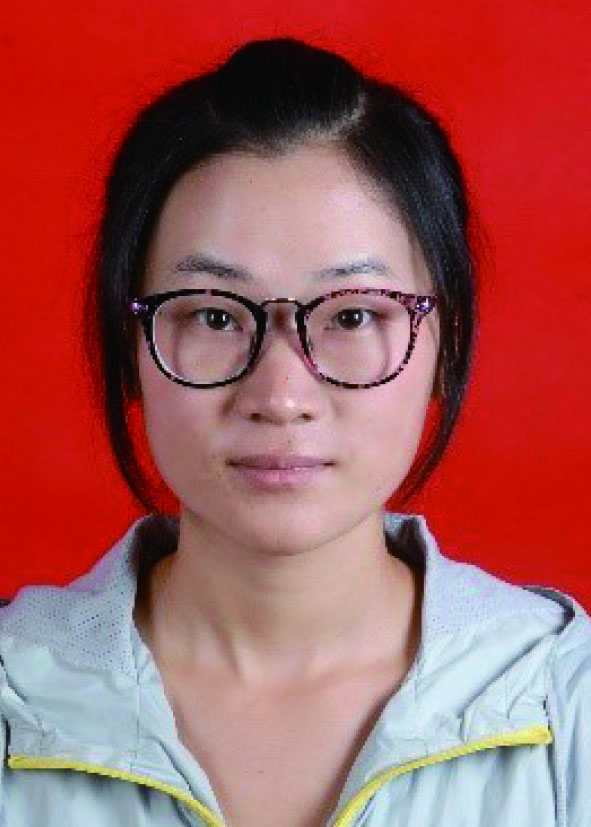 Hua Li:got her BS degree in 2015 and MS degree in 2018 at Lanzhou University. She then joined Weigao Xu’s group and got her PhD degree in 2021 at Nanjing University. Now she is an associate research fellow at Nanjing University. Her research interest focuses on the optical spectroscopy and microscopic imaging at the interfaces
Hua Li:got her BS degree in 2015 and MS degree in 2018 at Lanzhou University. She then joined Weigao Xu’s group and got her PhD degree in 2021 at Nanjing University. Now she is an associate research fellow at Nanjing University. Her research interest focuses on the optical spectroscopy and microscopic imaging at the interfaces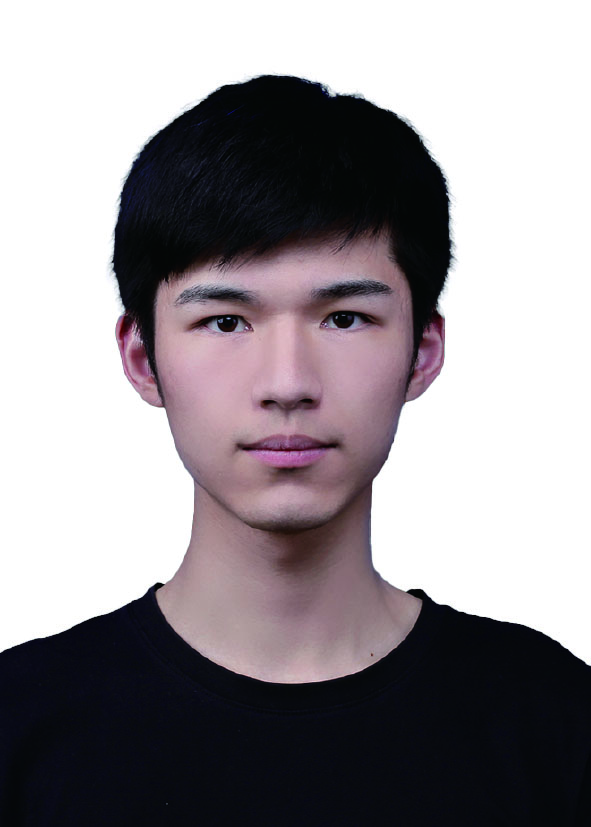 Jinyang Ling:received his BS degree in Chemistry from Nanjing University in 2021 and is currently pursuing his MS in Physical Chemistry under the supervision of Prof. Weigao Xu at the School of Chemistry and Chemical Engineering in Nanjing University. His research focuses on the excitonic dynamics of 2D layered materials in the in-plane direction, and corresponding excitonic optoelectronic devices
Jinyang Ling:received his BS degree in Chemistry from Nanjing University in 2021 and is currently pursuing his MS in Physical Chemistry under the supervision of Prof. Weigao Xu at the School of Chemistry and Chemical Engineering in Nanjing University. His research focuses on the excitonic dynamics of 2D layered materials in the in-plane direction, and corresponding excitonic optoelectronic devices Jiamin Lin:received her BS degree in Materials Science and Engineering from Nanjing University of Science and Technology in 2020 and she is currently pursuing her PhD at institute of Chemistry and Chemical Engineering, Nanjing University, under the supervision of Prof. Weigao Xu. Her research interests include low-dimensional materials and their optothermal transport behavior
Jiamin Lin:received her BS degree in Materials Science and Engineering from Nanjing University of Science and Technology in 2020 and she is currently pursuing her PhD at institute of Chemistry and Chemical Engineering, Nanjing University, under the supervision of Prof. Weigao Xu. Her research interests include low-dimensional materials and their optothermal transport behavior Xin Lu:earned her bachelor’s degree from Wuhan University in 2012, and her PhD from Nanyang Technological University in 2017. Subsequently, Lu joined Prof. Ajit Srivastava’s group at Emory University as a postdoctoral researcher. Since January 2021, Lu has started as an Assistant Professor in the Department of Physics and Engineering Physics at Tulane University. Her research focuses on optical spectroscopy of low-dimensional materials
Xin Lu:earned her bachelor’s degree from Wuhan University in 2012, and her PhD from Nanyang Technological University in 2017. Subsequently, Lu joined Prof. Ajit Srivastava’s group at Emory University as a postdoctoral researcher. Since January 2021, Lu has started as an Assistant Professor in the Department of Physics and Engineering Physics at Tulane University. Her research focuses on optical spectroscopy of low-dimensional materials Weigao Xu:got his BS degree in 2008 at Lanzhou University and PhD degree in 2013 at Peking University. Then he joined Qihua Xiong’s group as a postdoc at Nanyang Technological University in Singapore. In March 2018, he joined Nanjing University as a full professor. His research interest focuses on the bottom-up assembly of meso-scale materials from nanomaterial units, the discovery of their optical, electrical, mechanical, and chemical properties, and the development of their functionalities
Weigao Xu:got his BS degree in 2008 at Lanzhou University and PhD degree in 2013 at Peking University. Then he joined Qihua Xiong’s group as a postdoc at Nanyang Technological University in Singapore. In March 2018, he joined Nanjing University as a full professor. His research interest focuses on the bottom-up assembly of meso-scale materials from nanomaterial units, the discovery of their optical, electrical, mechanical, and chemical properties, and the development of their functionalities




